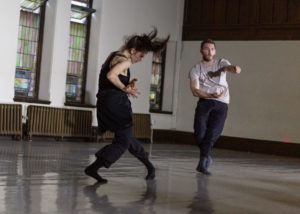Running Hard: Belinda McGuire, mid-career and independent in New York - Vancouver Ballet Society
- Home
- Features 2020 - 2023
- Running Hard: Belinda McGuire, mid-career and independent in New York

By Rachel Silver Maddock
Music is pumping at the Vancouver café where we sit, surrounded by exposed red brick and industrial-cut wooden benches and tables. Belinda McGuire gently holds a cappuccino with two fingers. Her lightly freckled face has that post-rehearsal glow, and her eyes light up as she makes a sudden realization: “In a way, I’ve been training for this duet my whole life.”

The Brooklyn-based dance artist is in Vancouver for a few days to rehearse and perform The Other Half, a duet co-choreographed and performed with Vanessa Goodman, at the Chutzpah Festival.
What McGuire is getting at is that one of the central ideas of The Other Half lines up with a vocational goal of her own: to “try on” the movement and worldview of another dancer and, in the process, enrich her own perspective.
She met Goodman when they were both students at Canadian Contemporary Dance Theatre (CCDT) in Toronto. The Other Half, which premiered last October at Fluid Fest in Calgary, explores their shared muscle memory and also the individual physicalities developed through dance careers that took the two in different directions — Goodman to Vancouver and McGuire to New York, where she founded her one-woman company, Belinda McGuire Dance Projects.
Earlier that day, I watched Goodman and McGuire rehearse in a sun-soaked studio in Gastown. As they ran the work, I was captivated watching McGuire “try on” Goodman’s physicality — movement behaviours and response strategies that had her gesturing and isolating different body parts in quick succession. Though the two petite women look a bit similar in their black costumes, with brown hair in top knots, their ways of moving are totally different. As she dances, McGuire’s influences from classical ballet and modern dance styles arrive in fleeting sculptural moments: a head tossed back with one leg in attitude devant, a gentle Graham-esque articulation of the torso, an impossibly light yet weighted fall and return to standing.
Earlier, McGuire explained that she steers herself as a dance artist by being “a curator” of the many influences that have gone into her training, which started at age seven in a Toronto dance academy. She was an analytic child, product of a musician and scientist — her mother is a professional violinist and her father an epidemiologist. At age 11, she discovered modern dance at CCDT and fell in love with it. Upon graduating from high school, she considered pursuing either science or dance at the undergraduate level. At the time, she reflects, she wasn’t really aware of all the options available to her and only auditioned for one dance school: Juilliard in New York. When she got in, the decision was made.

Gothamfotografia
Even though she went the way of dance, McGuire often approaches her art practise from a scientific perspective. “Treating art-making like the scientific process isn’t something I [consciously] tried to do,” she says, “but something I found myself falling into. You start with a hypothesis, a thing you think is probably true that you’re exploring.” Sometimes when she is training or teaching, a scientific approach helps her solve problems. When she’s stuck, isolating the surrounding variables can help her gain insight into a movement or feeling.
When McGuire graduated from Juilliard, she immediately got her “dream” job, dancing for Doug Varone and Dancers. Over the next decade she danced for several groups in New York, including the Limón Dance Company, Gallim Dance, Lar Lubovitch Dance Company and Joshua Beamish’s MOVETHECOMPANY. But as opportunities and her own ambition for solo work picked up, she found it difficult to juggle her schedule — most New York companies work on average 30 weeks a year, but require full availability.
And so in 2007, McGuire launched Belinda McGuire Dance Projects. She still guest dances for companies here and there, but as an independent artist she has the flexibility to seek out choreographers she finds inspiring, and especially to travel. She has followed her interests all over the world, performing in Brazil, China, Italy, Mexico, Switzerland and Thailand. She navigates funding by producing her own work, and started the Brooklyn-based Offset Dance Fest (now in its fourth year).
With so much on the go, what does day-to-day life look like? McGuire says, with a laugh, it is a bit of a “wild west.” She often packs as much into each day as she can, embracing the feeling of being fully immersed in one thing to the next. Her physical training comes first: she runs for cardio and endurance, and often takes ballet (“I love how specific the goals are”) and Graham technique (“It’s so useful to get the points of your torso to work together as an ensemble”). She teaches, does yoga and keeps on top of the large amount of administration that comes with being your own managerial and marketing team.
Reflecting on her career at this stage, the 36-year-old is reminded of watching the New York City Marathon runners. “The marathon recruits so much of them,”says McGuire, “and [through it] they really have a sense of what they’re made of. The point is not that they can run forever, but that they can run really hard for an almost impossible amount of time.” With so many exciting artistic opportunities at her fingertips, she says, “in these years of my life, it feels like that’s what I’m doing.”

